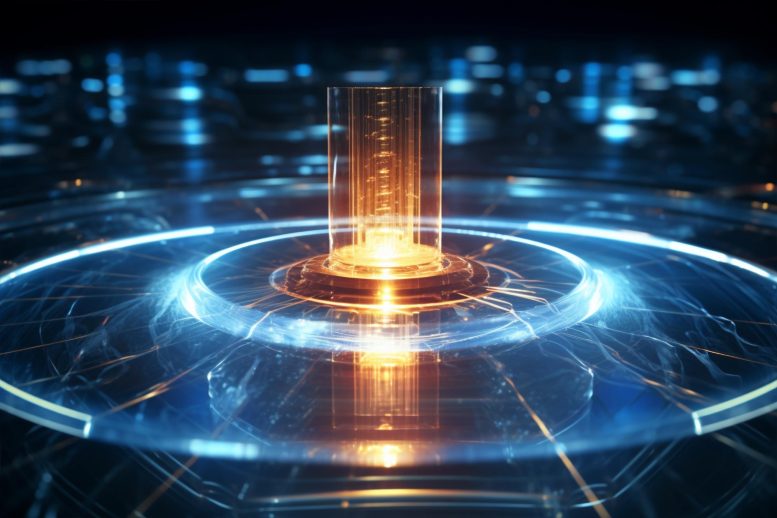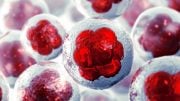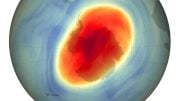
Researchers have developed a device that can disrupt the relationship between the absorption and emission efficiencies of an object, essentially violating Kirchhoff’s law of thermal radiation. This law, in place for over 150 years, states that an object’s ability to absorb and emit energy is equal at each wavelength and angle of incidence. This breakthrough could significantly impact sustainable energy harvesting systems and certain types of camouflage technology. (Artist’s concept.)
Scientists have developed a device that can break the principles of Kirchhoff’s law of thermal radiation, disrupting the traditional relationship between absorption and emission efficiencies in an object. This novel approach could enhance the efficiency of energy-harvesting systems and affect camouflage technologies.
If you take an object and set it out in the sun, it will begin to warm up. This is because it is absorbing energy from the sun’s rays and converting that energy to heat. If you leave that object outside it will continue getting warmer, but only to a point. A sunbather lying on a beach won’t catch fire, after all.
As objects (or people) absorb energy (light from the sun), they also emit energy (infrared radiation, or heat). This is something you may have experienced while walking past a block wall on a summer afternoon and feeling heat emanating from it.
Understanding Kirchhoff’s Law
The connection between an object’s ability to absorb and emit energy in the form of electromagnetic radiation—its absorptive and emissive efficiencies—has long been explained by something known as Kirchhoff’s law of thermal radiation. The law, a concept devised by Gustav Kirchhoff in 1860, which states absorptive and emissive efficiencies are equal at each wavelength and angle of incidence. (A more in-depth explanation of Kirchhoff’s law can be found here.)
Breaking Kirchhoff’s Law
A new device developed in the lab of Harry Atwater, the Howard Hughes Professor of Applied Physics and Materials Science, breaks that normally tight relationship between the absorbed and emitted efficiencies of an object. The invention may also have important implications for sustainable energy harvesting systems and the development of certain kinds of camouflage.
“Kirchhoff’s law has been upheld for more than 150 years, and while theoretical proposals for its violation have been advanced before, this is the first experimental proof that this law can be broken,” says Atwater.
Looking Into the Future of Energy Absorption
Electrical engineering graduate student Komron Shayegan, lead author of the new research, further explains:
“The equality dictated by Kirchhoff’s law has been a guiding principle in the design of devices that absorb and emit energy in the form of radiation, because by designing around and measuring the absorptive properties of a material, we get the emissive properties for free. However, there has been a recent shift when designing emitters/absorbers, namely that we are trying to move beyond having a simple one-to-one equality between the emissivity and absorptivity of a body.
“One motivation behind decoupling the two is in energy-harvesting systems. For example, if an energy-harvesting object, like a photovoltaic (solar panel), is re-emitting some of its absorbed energy back toward the energy source (the Sun) as heat, that energy is lost to human purposes. In theory, if the photovoltaic— or other energy-harvesting object —were to re-emit absorbed radiation away from the source and toward yet another energy-harvesting object, one could reach higher energy conversion efficiencies.
“Our study shows that it is possible to break the equality of Kirchhoff’s law of thermal radiation with a device placed in a moderate magnetic field. The device itself combines a material that has a strong magnetic-field response with a patterned structure that enhances absorption and emission in infrared wavelengths. What is particularly exciting is that we can observe the effect by simply heating the device above room-temperature and directly comparing the emissive efficiency to the absorptive efficiency.”
The paper describing the work, “Direct Observation of Kirchhoff Thermal Radiation Law Violation,” appears in the July 24 issue of the journal Nature Photonics.
Reference: “Direct observation of the violation of Kirchhoff’s law of thermal radiation” by Komron J. Shayegan, Souvik Biswas, Bo Zhao, Shanhui Fan and Harry A. Atwater, 24 July 2023, Nature Photonics.
DOI: 10.1038/s41566-023-01261-6
Co-authors are Souvik Biswas, formerly of Caltech and now at Stanford University; Bo Zhao of the University of Houston; Shanhui Fan of Stanford University; and Harry Atwater, who is also the Otis Booth Leadership Chair of the Division of Engineering and Applied Science and director of the Liquid Sunlight Alliance.
Funding for the research was provided by the Defense Advanced Research Projects Agency.









Good stuff
Been thinking about Kirchoff a lot recently but can’t recall ever seeing this law in thermodynamics study required for my BSEE, however that was about 40 years ago, and I took thermodynamics in a summer session.
Anyway, there could be a link to dark matter lurking somewhere in this fascinating revelation although I’m not sure I have any grasp on how this brand new technology works. Consider the viewing angle for NGC 1277 luminosity versus luminosity along “X” dual light-cone pattern seen in NGC 2424. NGC 1277 most likely only seems to lack DM because it’s so bright, and the only reason NGC 1277 is so “lacking in dark matter” is most likely due to the viewing angle and its lack of a bulge to diffuse light following along a leg of its own “X” pattern of light.
There is no evidence that the compact lenticular galaxy NGC 1277 has a specific light pattern like the spiral galaxy NGC 2424 may have.
NGC 1277 does not seem to lack dark matter, it seems to have a mere 6 % proportion of it. But it is *possible* at the low resolution of the data that the proportion could be 0 %. However it was a first test of a new method, and no group has repeated it yet on that or any other galaxy.
Moreover, the reference galaxy used was also odd without the work explaining why, it had a 14 % dark matter proportion where 10 % was the earlier lowest estimated for any galaxy at all. If we assume it had a more normal proportion of 70 %, then NGC 1277 would have a comfortable 35 % dark matter proportion.
[I should add that another odd thing with the method was that they tried to capture whole galaxies in such a way that they deliberately lowered the signal-to-noise ratio of the procedure.]
Another cool metamaterial application!